Introduction
The results reported in the April 2023 bank lending survey (BLS) relate to changes observed during the first quarter of 2023 and expectations for the second quarter of 2023. The survey was conducted between 22 March and 6 April 2023. In the first quarter of 2023, the size of the sample was increased to 158 banks, reflecting mainly the enlargement of the euro area to include Croatia on 1 January 2023. The response rate was 100%. In addition to results for the euro area as a whole, this report also contains results for the four largest euro area countries.[1]
A number of ad hoc questions were included in the April 2023 survey. They address the impact of the situation in financial markets on banks’ access to retail and wholesale funding, the impact of the ECB’s monetary policy asset portfolio and TLTRO III on banks and their lending policies, and the impact of ECB key interest rate decisions on bank profitability.
1 Overview of results
In the April 2023 BLS, euro area banks indicated that their credit standards for loans or credit lines to enterprises tightened further substantially in the first quarter of 2023. From a historical perspective, the pace of net tightening in credit standards remained at the highest level since the euro area sovereign debt crisis in 2011. The tightening was stronger than banks had expected in the previous quarter and points to a persistent weakening of loan dynamics. Risks related to the economic outlook and firm-specific situation remained the main driver of the tightening of credit standards, while banks’ lower risk tolerance also contributed. The tightening impact of banks’ cost of funds and balance sheet situation on credit standards for loans to firms remained contained and broadly unchanged compared with the previous quarter. In the second quarter of 2023, euro area banks expect a further, though more moderate tightening for loans to firms.
Banks also reported a further substantial net tightening of credit standards for housing loans in the first quarter of 2023, while the net tightening became less pronounced for consumer credit. The net tightening of credit standards on housing loans was mainly owing to banks’ higher risk perceptions and lower risk tolerance, while the tightening contribution of banks’ cost of funds and balance sheet constraints remained contained. In the second quarter of 2023, euro area banks expect a further, though more moderate, net tightening for loans to households for house purchase and a further net tightening at a similar pace as in the first quarter for consumer credit.
Firms’ net demand for loans fell strongly in the first quarter of 2023. The decline in net demand was stronger than expected by banks in the previous quarter and the strongest since the global financial crisis. The general level of interest rates was reported as the main driver of reduced loan demand, in an environment of monetary policy tightening. Fixed investment also had a strong dampening impact while the impact of inventories and working capital turned broadly neutral, after having previously had a positive impact on loan demand. In the second quarter of 2023, banks expect a further, albeit smaller net decline in demand for loans to firms.
The net decrease in housing loan demand remained strong and close to the sharp net decrease in the fourth quarter of 2022, which was the highest since the start of the survey in 2003. It was driven by higher interest rates, weakening housing market prospects and low consumer confidence. By contrast, the net decrease in demand for consumer credit became smaller. In the second quarter of 2023, banks expect a markedly less pronounced decrease in housing loan demand and a somewhat smaller net decrease in demand for consumer credit than in the first quarter.
In more detail, euro area banks tightened further substantially their credit standards (i.e. banks’ internal guidelines or loan approval criteria) for loans or credit lines to enterprises in the first quarter of 2023 (net percentage of banks at 27%, after 27% in the previous quarter; see Overview table), i.e. the percentage of banks reporting a tightening of credit standards was substantially larger than the percentage of banks reporting an easing. From a historical perspective, the pace of net tightening in credit standards remained at the highest level since the euro area sovereign debt crisis in 2011. The tightening was stronger than banks had expected in the previous quarter and points to a persistent weakening of loan dynamics. Banks’ risk perceptions continued to have the strongest tightening contribution, while declining risk tolerance also contributed towards a tightening. The impact of banks’ cost of funds and balance sheet constraints remained contained and in line with the impact registered in the previous quarter. Within the cost of funds and balance sheet constraints, the largest contributor towards a tightening was banks’ liquidity position, likely also reflecting the decrease in central bank liquidity support, in the context of ongoing TLTRO repayments. In the second quarter of 2023, euro area banks expect a further, though more moderate, net tightening of credit standards relative to the first quarter (net percentage of 15%).
For housing loans, euro area banks reported a further substantial net tightening of credit standards in the first quarter of 2023, at a similar pace as in the previous quarter (net percentage of banks of 19%, after 21% in the previous quarter; see Overview table), while the additional tightening became moderate for consumer credit (10%, after 17%). For housing loans, the net tightening was above banks’ expectations in the previous quarter (net percentage of 13%), but remained markedly below the peak observed in the third quarter of 2022. For consumer credit, the net tightening was broadly in line with banks’ expectations (net percentage of 13%). The main drivers of the tightening for both housing loans and consumer credit were higher risk perceptions and, to a lesser extent, banks’ lower risk tolerance. The tightening contribution of banks’ cost of funds and balance sheet constraints remained contained and broadly unchanged from the previous quarter. Similar to the credit standards applied to loans to firms, the tightening was mainly on account of banks’ decreasing liquidity position. In the second quarter of 2023, banks expect a further, though more moderate, net tightening of credit standards for housing loans (net percentage of 6%). For consumer credit, they expect a further net tightening of credit standards at a similar pace as in the first quarter of 2023 (12%).
Banks’ overall terms and conditions (i.e. banks’ actual terms and conditions agreed in the loan contract) for new loans to firms and households tightened further. For firms, the difference between the percentage of banks reporting a tightening and the percentage of banks reporting an easing was still substantial but lower than the last quarter (net percentage of 24%, after 38%). The widening of margins on riskier loans had the strongest tightening contribution. Margins on average loans widened but at a lesser pace than in the previous quarter, while collateral requirements also had a tightening impact on terms and conditions. Banks also reported a further net tightening of overall terms and conditions for housing loans (net percentage of 26%, after 31%) and consumer credit and other lending to households (18%, after 21%). For both, the tightening was mainly on account of the rising level of interest rates (part of “other factors”) and, especially for housing loans, widening margins on riskier loans, reflecting the ongoing pass-through of higher market rates to mortgage rates and consumer credit rates. At the same time, competition contributed to an easing of banks’ terms and conditions for loans to households.
In the first quarter of 2023, banks reported a widespread increase in the share of rejected applications for all loan categories, reaching – for loans to firms – the highest net percentage registered since the question was first asked in 2015 (net percentage of 15%, after 12% in the previous quarter). This is consistent with a further tightening of credit standards, which makes banks increasingly more likely to reject loan applications despite the decrease in loan demand. For housing loans and consumer credit, the further net increase in the share of rejected applications, although reported by fewer banks compared with the previous quarter, remains at historically high levels (17% after 27%, and 10% after 19% respectively).
Credit standards for loans to enterprises tightened in net terms in all four of the largest euro area countries in the first quarter of 2023 (see Overview table). Credit standards for housing loans also tightened across all four largest euro area countries in the first quarter, while credit standards for consumer credit and other lending to households tightened in Germany and Spain and remained unchanged in France and Italy.
Firms’ net demand for loans decreased strongly in the first quarter of 2023 (net percentage of -38%, after -12% in the previous quarter; see Overview table), which is the largest net decline since the fourth quarter of 2008. The decline was stronger than expected by banks in the previous quarter. The general level of interest rates was reported as the main driver of reduced loan demand, in an environment of monetary policy tightening. Fixed investment also had a strong dampening impact on loan demand. The impact of inventories and working capital turned broadly neutral, after having previously had a positive impact on loan demand, which may reflect the easing of supply bottlenecks and a moderation in energy input costs. In the second quarter of 2023, banks expect a further, albeit smaller net decline in demand for loans to firms (net percentage of -18%).
The net decrease in demand for housing loans remained strong in the first quarter of 2023 and close to the sharp net decrease in the previous quarter (net percentage of -72%, after -74% in the previous quarter; see Overview table). Both decreases were stronger than in any other quarter since the beginning of the survey in 2003. The decrease in the first quarter was stronger than expected by banks in the fourth quarter of 2022. Higher interest rates, weakening housing market prospects and low consumer confidence all contributed negatively to the demand for loans for house purchase. By contrast, the net decrease in demand for consumer credit became smaller (net percentage of -19%, after -30%, see Overview table), broadly in line with what banks had expected in the previous quarter. Higher interest rates, low consumer confidence and declining spending on durable consumer goods contributed to lower demand. In the second quarter of 2023, banks expect a further, although less strong decrease in housing loan demand (net percentage of -39%) and a similar net decrease in demand for consumer credit (-16%) than in the first quarter.
Banks reported a net decrease in demand for loans across all four largest euro area countries in the first quarter of 2023. Across all four largest countries, demand for loans to enterprises decreased in net terms. In addition, net demand for housing loans decreased substantially in all four largest euro area countries, with very large net decreases in Germany, Spain and France. Demand for consumer credit decreased in net terms in Germany, Spain and, to a lesser extent, in Italy, while it remained unchanged in France.
Overview table
Latest BLS results for the largest euro area countries
(net percentages of banks reporting a tightening of credit standards or an increase in loan demand)
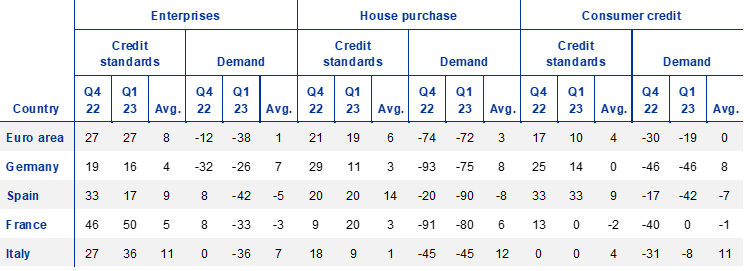
Notes: “Avg.” refers to historical averages, which are calculated over the period since the beginning of the survey, excluding the most recent round. Owing to the different sample sizes across countries, which broadly reflect the differences in the national shares in lending to the euro area non-financial private sector, the size and volatility of the net percentages cannot be directly compared across countries.
The April 2023 BLS also contained a number of ad hoc questions. Euro area banks reported that their access to retail and wholesale funding deteriorated in the first quarter of 2023. For money markets and debt securities, the deterioration reverses the improvement in the access to these markets registered at the end of last year, possibly reflecting the March 2023 market turmoil, the lower overall level of excess liquidity and the increased collateral availability that had stemmed from TLTRO III voluntary early repayments in the last quarter of 2022. For retail funding, the pace of deterioration in access to funding remained similar to the previous quarter and reflects the continued increase in bank deposit rates and shifts towards more highly remunerated types of saving. In the second quarter of 2023, access to all sources of retail and wholesale funds is expected to deteriorate further.
Banks reported that the ECB’s monetary policy asset portfolio – for which changes can arise as a result of any transactions, including less than full reinvestments – had a negative impact on their market financing conditions, liquidity positions and total assets over the last six months. Banks also noted that the impact on profitability was broadly neutral, although the impact via capital losses remained negative. The ECB’s monetary policy asset portfolio also had a net tightening impact on terms and conditions for loans to firms and households, while there was a negative impact on lending volumes across all categories of lending for the first time since this question was introduced. Banks expect that the impact on market financing conditions, liquidity positions and total assets will continue to be negative over the next six months, while the tightening impact on terms and conditions and the negative impact on lending volumes are also expected to continue.
Euro area banks indicated a negative impact of the ongoing phase-out of TLTRO III on their liquidity positions, profitability and their overall funding conditions over the last six months, which is expected to continue over the next six months against the backdrop of TLTRO III funds maturing or being voluntarily repaid early, leading to a reduction in lending volumes. TLTRO III had a tightening impact on credit standards for loans to firms, and a small net tightening impact on loans to households. Over the next six months, credit standards are expected to tighten further especially as a consequence of the largest remaining TLTRO III operation maturing in June 2023. Against the same backdrop, while the impact on terms and conditions was still only slightly tilted towards tightening over the past six months, the phase-out of TLTRO III is expected to lead to a widespread tightening over the second and third quarter of this year. The impact on lending volumes is expected to turn negative across all categories of lending over the next six months.
Euro area banks indicated a markedly positive impact of the ECB key interest rate decisions on their net interest margins over the past six months, according to a new question which was introduced in this survey round. The positive impact on bank interest margins also translated into a high share of banks reporting a positive impact of the ECB rate hikes on their net interest income, which led to a largely positive effect on their overall profitability. At the same time, the impact of the interest rate decisions on volumes was negative, consistent with sharply decelerating loan demand as reported elsewhere in the survey and weakening deposit dynamics. Moreover, euro area banks reported a negative impact of the ECB interest rate decisions on their non-interest income, due to both capital losses and lower net fee and commission income, and a negative impact via higher provisioning needs and impairments. Banks expect mostly similar impacts of the ECB key interest rate decisions on the components of bank profitability over the next six months, except for capital losses, which banks expect to be lower.
Box 1
General notes
The bank lending survey (BLS) is addressed to senior loan officers at a representative sample of euro area banks. In the current round, 158 banks were surveyed, representing all euro area countries and reflecting the characteristics of their respective national banking structures. The main purpose of the BLS is to enhance the Eurosystem’s knowledge of bank lending conditions in the euro area.[2]
BLS questionnaire
The BLS questionnaire contains 22 standard questions on past and expected future developments: 18 backward-looking questions and four forward-looking questions. In addition, it contains one open-ended question. Those questions focus on developments in loans to euro area residents (i.e. domestic and euro area cross-border loans) and distinguish between three loan categories: loans or credit lines to enterprises; loans to households for house purchase; and consumer credit and other lending to households. For all three categories, questions are asked about the credit standards applied to the approval of loans, the terms and conditions of new loans, loan demand, the factors affecting loan supply and demand conditions, and the percentage of loan applications that are rejected. Survey questions are generally phrased in terms of changes over the past three months or expected changes over the next three months. Survey participants are asked to indicate in a qualitative way the strength of any tightening or easing or the strength of any decrease or increase, reporting changes using the following five-point scale: (1) tightened/decreased considerably, (2) tightened/decreased somewhat, (3) basically no change, (4) eased/increased somewhat, or (5) eased/increased considerably.
In addition to the standard questions, the BLS questionnaire may contain ad hoc questions on specific topics of interest. Whereas the standard questions cover a three-month time period, the ad hoc questions tend to refer to changes over a longer time period (e.g. over the past and next six months).
Aggregation of banks’ replies to national and euro area BLS results
The responses of the individual banks participating in the BLS are aggregated in two steps to form the euro area results. In the first step, the responses of individual banks are aggregated to national results for the euro area countries. In the second step, the national BLS results are aggregated to euro area BLS results.
In the first step, banks’ replies are aggregated to national BLS results for all countries by applying equal weights to all banks in the sample.[3] For two countries (Malta and Slovakia), national results are additionally aggregated by applying a weighting scheme based on the amounts outstanding of loans to non-financial corporations and households of the individual banks in the respective national samples.
In the second step, since the numbers of banks in the national samples differ considerably and do not always reflect those countries’ respective shares in lending to euro area non-financial corporations and households, the unweighted national survey results of all countries are aggregated to euro area BLS results by applying a weighting scheme based on the national shares of outstanding loans to euro area non-financial corporations and households.
BLS indicators
Responses to questions relating to credit standards are analysed in this report by looking at the difference (the “net percentage”) between the percentage of banks reporting that credit standards applied in the approval of loans have been tightened and the percentage of banks reporting that they have been eased. For all questions, the net percentage is determined on the basis of all participating banks that have business in or exposure to the respective loan categories (i.e. they are all included in the denominator when calculating the net percentage). This means that banks that specialise in certain loan categories (e.g. banks that only grant loans to enterprises) are only included in the aggregation for those categories. All other participating banks are included in the aggregation of all questions, even if a bank replies that a question is “not applicable” (“NA”). This harmonised aggregation method was introduced by the Eurosystem in the April 2018 BLS. It has been applied to all euro area and national BLS results in the current BLS questionnaire, including backdata.[4] The resulting revisions for the standard BLS questions have generally been small, but revisions for some ad hoc questions have been larger owing to a higher number of “not applicable” replies by banks.
A positive net percentage indicates that a larger proportion of banks have tightened credit standards (“net tightening”), whereas a negative net percentage indicates that a larger proportion of banks have eased credit standards (“net easing”).
Likewise, the term “net demand” refers to the difference between the percentage of banks reporting an increase in loan demand (i.e. an increase in bank loan financing needs) and the percentage of banks reporting a decline. Net demand will therefore be positive if a larger proportion of banks have reported an increase in loan demand, whereas negative net demand indicates that a larger proportion of banks have reported a decline in loan demand.
In the assessment of survey balances for the euro area, net percentages between -1 and +1 are generally referred to as “broadly unchanged”. For country results, net percentage changes are reported in a factual manner, as differing sample sizes across countries mean that the answers of individual banks have differing impacts on the magnitude of net percentage changes.
In addition to the “net percentage” indicator, the ECB also publishes an alternative measure of banks’ responses to questions relating to changes in credit standards and net demand. This measure is the weighted difference (“diffusion index”) between the percentage of banks reporting that credit standards have been tightened and the percentage of banks reporting that they have been eased. Likewise, as regards demand for loans, the diffusion index refers to the weighted difference between the percentage of banks reporting an increase in loan demand and the percentage of banks reporting a decline. The diffusion index is constructed in the following way: lenders who have answered “considerably” are given a weight (score of 1) which is twice as large as that given to lenders who have answered “somewhat” (score of 0.5). The interpretation of the diffusion indices follows the same logic as the interpretation of net percentages.
Detailed tables and charts based on the responses provided can be found in Annex 1 for the standard questions and Annex 2 for the ad hoc questions. In addition, BLS time series data are available on the ECB’s website via the Statistical Data Warehouse.
A copy of the questionnaire, a glossary of BLS terms and a BLS user guide with information on the BLS series keys can all be found on the ECB's website.
2 Developments in credit standards, terms and conditions, and net demand for loans in the euro area
2.1 Loans to enterprises
2.1.1 Credit standards for loans to enterprises tightened further substantially
Euro area banks tightened further substantially their credit standards for loans or credit lines to enterprises in the first quarter of 2023, i.e. the percentage of banks reporting a tightening of credit standards was substantially larger than the percentage of banks reporting an easing (net percentage of banks of 27%, after 27% in the fourth quarter of 2022; see Chart 1 and Overview table). The net tightening in credit standards was stronger than banks had expected in the previous quarter and points to a persistent weakening of loan dynamics. Looking at developments from a historical perspective, the pace of net tightening in credit standards for the last two quarters is the largest seen since the sovereign debt crisis (net percentage of 35% recorded in the fourth quarter of 2011). Credit standards tightened to a similar extent for loans to small and medium-sized enterprises (SMEs; net percentage of 23%, after 22%) and for loans to large firms (24%, after 20%; see Chart 2). At the same time, the tightening was stronger for long-term loans (28%, after 27%) than for short-term loans (17%, after 20%).
Risks related to the economic outlook and industry or firm-specific situation had the largest tightening impact on credit standards for firms (see Chart 1 and Table 1). To a lesser extent, banks’ declining risk tolerance also had a tightening impact. The significant tightening impact is broadly in line with developments in the European Commission’s economic sentiment indicator, which remained slightly below its long-run average in the first quarter. Against the backdrop of increases in ECB key interest rates and decreases in central bank liquidity, banks’ cost of funds and balance sheet conditions also had a tightening impact on credit standards for loans to euro area firms. Within the cost of funds and balance sheet constraints, the largest contributor towards a tightening was banks’ liquidity position, likely also reflecting a decrease in central bank liquidity associated with maturing and early repayments of TLTRO III funds and, since March, the lower reinvestments of ECB’s monetary policy asset portfolio (see Section 4). Factors contributing to changes in credit standards were similar for SMEs and large enterprises.
Chart 1
Changes in credit standards applied to the approval of loans or credit lines to enterprises, and contributing factors
(net percentages of banks reporting a tightening of credit standards and contributing factors)
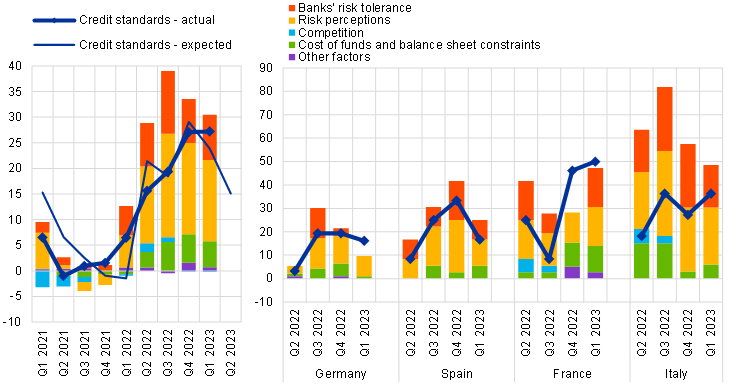
Notes: “Actual” values are changes that have occurred, while “expected” values are changes anticipated by banks. Net percentages are defined as the difference between the sum of the percentages of banks responding “tightened considerably” and “tightened somewhat” and the sum of the percentages of banks responding “eased somewhat” and “eased considerably”. The net percentages for responses to questions related to contributing factors are defined as the difference between the percentage of banks reporting that the given factor contributed to a tightening and the percentage reporting that it contributed to an easing. “Cost of funds and balance sheet constraints” is the unweighted average of “banks’ capital and the costs related to banks’ capital position”, “access to market financing” and “liquidity position”; “risk perceptions” is the unweighted average of “general economic situation and outlook”, “industry or firm-specific situation and outlook/borrower’s creditworthiness” and “risk related to the collateral demanded”; “competition” is the unweighted average of “competition from other banks”, “competition from non-banks” and “competition from market financing”. The net percentages for “other factors” refer to further factors which were mentioned by banks as having contributed to changes in credit standards.
Chart 2
Changes in credit standards applied to the approval of loans or credit lines to SMEs and large enterprises, and contributing factors
(net percentages of banks reporting a tightening of credit standards and contributing factors)

Note: See the notes to Chart 1.
Credit standards for loans to enterprises tightened across all four largest euro area countries, driven mainly by higher risk perceptions. Declining risk tolerance and banks’ cost of funds and balance sheet conditions also had a tightening contribution in France, Italy and Spain. In Germany, the contribution of cost of funds and balance sheet conditions was broadly neutral, although there was a small tightening impact of banks’ access to market financing.
In the second quarter of 2023, euro area banks expect a further, though more moderate, net tightening of credit standards relative to the first quarter (net percentage of 15%). Banks expect a net tightening both for loans to SMEs (net percentage of 12%) and large enterprises (net percentage of 13%).
Table 1
Factors contributing to changes in credit standards for loans or credit lines to enterprises
(net percentages of banks)

Note: See the notes to Chart 1.
2.1.2 Terms and conditions on loans to enterprises tightened further
Banks’ overall terms and conditions (i.e. actual terms and conditions agreed in the loan contract) for new loans to enterprises tightened further in the first quarter of 2023 (net percentage of 24%, after 38%; see Chart 3 and Table 2). There was a nil percentage of banks reporting an easing of overall terms and conditions, with the net percentage being driven by banks reporting a tightening, although to a lesser extent than in the last quarter. Tighter terms and conditions are confirmed by the continued rise in the aggregate cost of borrowing for firms seen in currently available interest rate data for the first quarter. The tightening in terms and conditions was mainly on account of a widening in margins (defined as the spread over relevant market reference rates) on riskier loans (net percentage of 20%) and to a lesser extent on average loans (net percentage of 8%). The widening of margins on riskier loans was broadly in line with the previous quarter, while the widening of margins on average loans was less pronounced. Collateral requirements (net percentage of 7%) and other terms and conditions also had a tightening impact on firms’ overall terms and conditions. Banks reported a further substantial, albeit lower, net tightening of overall terms and conditions for loans to both SMEs and large firms (see Chart 4). For both categories of lending, loan margins widened more for riskier loans than for average loans.
Chart 3
Changes in terms and conditions on loans or credit lines to enterprises
(net percentages of banks reporting a tightening of terms and conditions)
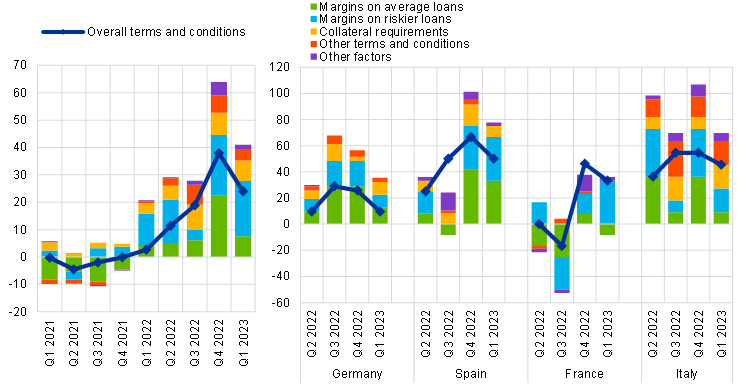
Notes: “Margins” are defined as the spread over relevant market reference rates. “Other terms and conditions” is the unweighted average of “non-interest rate charges”, “size of the loan or credit line”, “loan covenants” and “maturity”. The net percentages for “other factors” refer to further factors which were mentioned by banks as having contributed to changes in terms and conditions.
Chart 4
Changes in terms and conditions on loans or credit lines to SMEs and large enterprises
(net percentages of banks reporting a tightening of terms and conditions)

Note: See the notes to Chart 3.
Banks’ higher risk perceptions, decreased risk tolerance, and cost of funds and balance sheet constraints continued to be the main drivers of the net tightening in overall terms and conditions for loans to firms in the first quarter of 2023 (see Table 3), with rising inter-bank competition counterbalancing the trend. Risk perceptions related to the economic outlook and the creditworthiness of firms had a large tightening impact on terms and conditions, whereas the impact of the collateral demanded was more moderate. In the context of increases in ECB key interest rates and decreases in the central bank balance sheet, banks’ cost of funds and balance sheet constraints contributed towards the tightening, with the largest contribution from costs related to market financing. On the other hand, competition had an easing impact, driven by increased inter-bank competition, which can partially explain the lower pace of tightening in the first quarter.
Table 2
Changes in terms and conditions on loans or credit lines to enterprises
(net percentages of banks)

Note: See the notes to Chart 3.
Table 3
Factors contributing to changes in overall terms and conditions on loans or credit lines to enterprises
(net percentages of banks)

Notes: The net percentages for these questions relating to contributing factors are defined as the difference between the percentage of banks reporting that the given factor contributed to a tightening and the percentage reporting that it contributed to an easing. See the notes to Chart 1.
In all four largest euro area countries, overall terms and conditions tightened on loans or credit lines to enterprises. In Germany, the net tightening was lower relative to the other three largest euro area countries. Margins on riskier loans contributed towards a tightening across all four of the largest euro area countries, while margins on average loans had an easing impact in France, and a tightening impact in Germany, Italy and Spain. Banks in Germany, Italy and Spain also cited collateral requirements as having a tightening impact. In Italy, banks referred to the level of interest rates and increases of benchmark rates (in the “other factors”) having a tightening impact as well as to other terms and conditions, with the largest tightening impact amongst these being driven by restrictions on loan sizes and tighter maturity conditions.
2.1.3 Rejection rate for loans to enterprises increased
Euro area banks reported in the first quarter of 2023 the largest net increase in the share of rejected applications for loans to firms since this question was introduced in 2015 (net percentage of 15%, after 12% in the previous quarter; see Chart 5). This development is consistent with a further tightening in credit standards, which makes banks more likely to reject loan applications despite the decrease in loan demand. The net increase in the share of rejected loan applications was similar for loans to SMEs (net percentage of 11%, after 11%) and for loans to large firms (net percentage of 10%, after 10%).
Chart 5
Changes in the share of rejected loan applications for enterprises
(net percentages of banks reporting an increase)
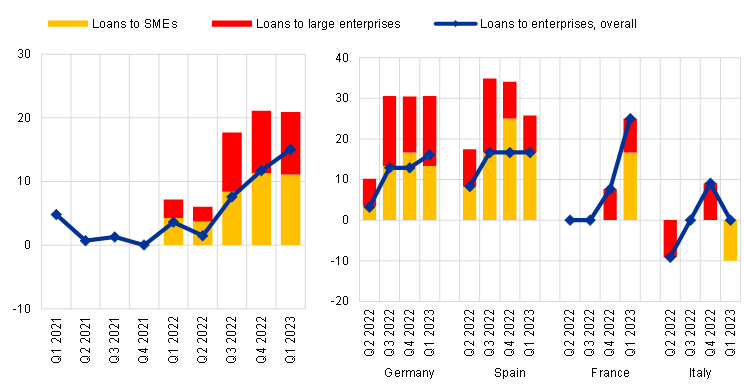
Notes: Share of rejected loan applications relative to the volume of all loan applications in that loan category. The breakdown by firm sizes was introduced in the first quarter of 2022.
Banks in France, Germany and Spain reported a net increase in the share of rejected applications for loans to firms in the first quarter of 2023, while there was no change in the share of rejected applications in Italy. The net share of rejected loan application increased for both SMEs and large enterprises in Germany, France and Spain, while the share of rejected applications slightly decreased for SMEs in Italy.
2.1.4 Net demand for loans to enterprises decreased strongly
According to euro area banks, firms’ net demand for loans decreased strongly in the first quarter of 2023 (net percentage of -38%, after -12% in the previous quarter; see Chart 6). This is the largest net decline since the fourth quarter of 2008 which was the strongest decline seen during the global financial crisis. The decline was stronger than expected by banks in the previous quarter. Loan demand decreased in net terms for SMEs (net percentage of -37%, see Chart 7) and large firms (net percentage of -31%). The net decrease in demand was particularly strong for long-term loans, at a pace similar to the highest rate seen during the global financial crisis (-45%, compared with -43% in the first quarter of 2009), while demand for short-term loans decreased to a lesser extent (-11%) after being broadly unchanged in the previous quarter.
Chart 6
Changes in demand for loans or credit lines to enterprises, and contributing factors
(net percentages of banks reporting an increase in demand, and contributing factors)
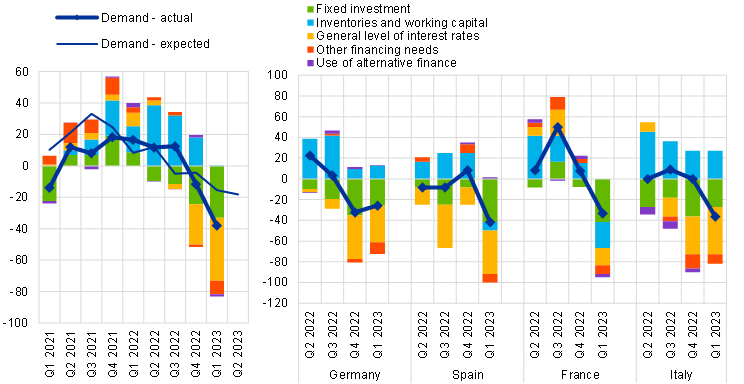
Notes: “Actual” values are changes that have occurred, while “expected” values are changes anticipated by banks. Net percentages for the questions on demand for loans are defined as the difference between the sum of the percentages of banks responding “increased considerably” and “increased somewhat” and the sum of the percentages of banks responding “decreased somewhat” and “decreased considerably”. The net percentages for responses to questions relating to contributing factors are defined as the difference between the percentage of banks reporting that the given factor contributed to increasing demand and the percentage reporting that it contributed to decreasing demand. “Other financing needs” is the unweighted average of “mergers/acquisitions and corporate restructuring” and “debt refinancing/restructuring and renegotiation”; “use of alternative finance” is the unweighted average of “internal financing”, “loans from other banks”, “loans from non-banks”, “issuance/redemption of debt securities” and “issuance/redemption of equity”.
Chart 7
Changes in demand for loans or credit lines to SMEs and large enterprises, and contributing factors
(net percentages of banks reporting an increase in demand, and contributing factors)
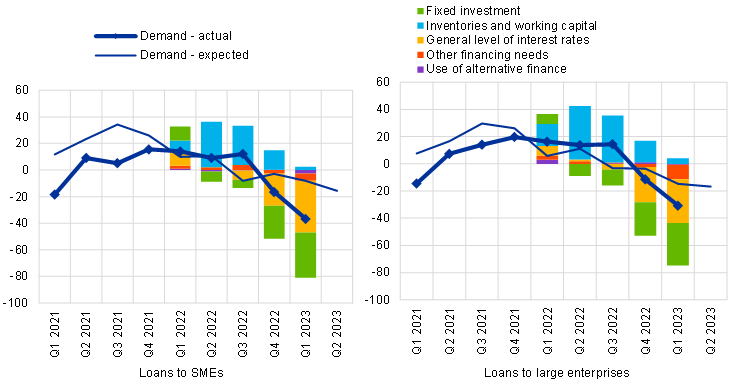
Note: See the notes to Chart 6. Developments in the factors having an impact on loan demand across firm sizes were added in the first quarter of 2022.
In the context of monetary policy tightening, the general level of interest rates was the main driver of reduced loan demand (net percentage of -40%, see Chart 6 and Table 4). In addition, fixed investment had a further dampening impact on loan demand (net percentage of -33%). The contribution of inventories and working capital turned neutral (net percentage of 0%) having previously had a positive impact on loan demand, which may reflect the easing of supply bottlenecks and a moderation in energy input costs. These developments reflect the latest euro area manufacturing Purchasing Managers’ Index (PMI) for March, in which supplier delivery times improved strongly and manufacturing input prices fell for the first time in almost three years, with a negative contribution from lower energy input costs. The use of alternative financing had an overall broadly neutral impact on loan demand (net percentage of -1%). On the one hand, debt security issuance had a positive impact (net percentage of 4%), suggesting some banks are seeing an increase in loan demand due to reduced issuance of corporate debt securities. On the other hand, the use of internal financing associated with improved corporate profitability had a dampening impact (net percentage of -10%). Other financing needs had an overall dampening impact on loan demand (net percentage of -9%), mainly due to financing needs relating to mergers and acquisitions and corporate restructuring (net percentage of -18%). For both SMEs and large firms, the general level of interest rates and firms’ financing needs related to fixed investment had a large dampening impact on demand (see Chart 7).
Table 4
Factors contributing to changes in demand for loans or credit lines to enterprises
(net percentages of banks)

Note: See the notes to Chart 6.
Demand for loans to firms fell across all four largest euro area countries. The general level of interest rates and financing needs related to fixed investment had a notable negative contribution to demand across all four large countries. The effect of inventories and working capital was more heterogeneous, with banks in Germany and Italy reporting a positive contribution towards loan demand, possibly pointing to input costs related to high energy prices or other short-term financing needs of firms such as remaining supply bottlenecks, while in France and Spain there was a dampening contribution. Banks in all four countries indicated that other financing needs, mostly related to mergers and acquisitions, had a negative contribution towards demand.
In the second quarter of 2023, banks expect a further, albeit smaller, net decline in demand for loans to firms (net percentage of -18%). Banks expect a significant, albeit smaller, decrease in demand for long-term loans (net percentage of -22%), while the demand for short-term loans is expected to decrease to a lesser extent (net percentage of -6%). Net demand for loans to both SMEs (net percentage of -16%) and large firms (net percentage of -17%) are expected to decrease at similar rates.
2.2 Loans to households for house purchase
2.2.1 Credit standards for loans to households for house purchase tightened further substantially
In the first quarter of 2023, euro area banks tightened further substantially their credit standards on loans to households for house purchase, at a similar pace as in the previous quarter (net percentage of banks at 19%, after 21% in the previous quarter). The pace of the tightening remained markedly below the peak observed in the third quarter of 2022 (see Chart 8 and Overview table). It also remained below the tightening peaks reached during the pandemic, the sovereign debt crisis and especially the global financial crisis.
Chart 8
Changes in credit standards applied to the approval of loans to households for house purchase, and contributing factors
(net percentages of banks reporting a tightening of credit standards, and contributing factors)
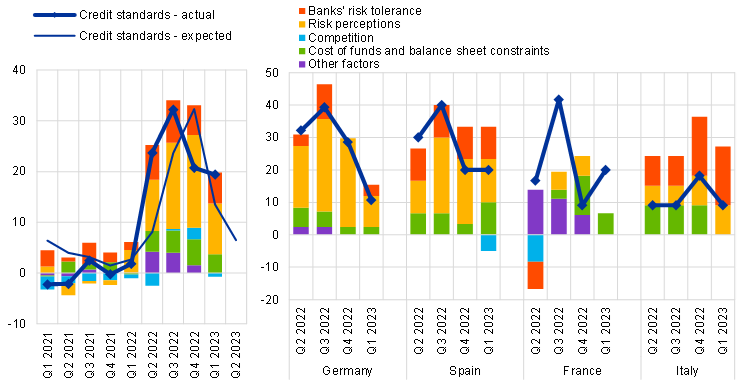
Notes: See the notes to Chart 1. “Cost of funds and balance sheet constraints” is the unweighted average of “banks’ capital and the costs related to banks’ capital position”, “access to market financing” and “liquidity position”; “Risk perceptions” is the unweighted average of “general economic situation and outlook”, “housing market prospects, including expected house price developments” and “borrower’s creditworthiness”; “competition” is the unweighted average of “competition from other banks” and “competition from non-banks”. The net percentages for “other factors” refer to further factors which were mentioned by banks as having contributed to changes in credit standards.
Banks’ higher risk perceptions were the main factor driving the net tightening of credit standards, albeit to a lesser extent than in the previous quarter (see Chart 8 and Table 5). This was mainly related to banks’ concerns regarding the general economic outlook, for which the additional tightening impact became smaller compared with the previous quarter, which would be consistent with a still subdued but improved outlook for euro area economic growth in the first quarter. In addition, banks’ lower risk tolerance continued to contribute to the tightening. The tightening contribution of banks’ cost of funds and balance sheet constraints remained contained. Similar to the credit standards applied to loans to firms, the tightening was mainly driven by banks’ liquidity positions. By contrast, the tightening impact of banks’ costs related to their capital positions and market financing remained small, also reflecting euro area banks’ solid capital position.
Across all four largest euro area countries, credit standards for loans to households for house purchase tightened in net terms. In most of these countries, banks’ risk perceptions and lower risk tolerance were the main drivers of the net tightening. At the same time, banks in Spain and France particularly referred to a tightening impact of banks’ cost of funds and balance sheet constraints, either due to their market financing conditions (Spain) or liquidity positions (France and Spain), while the costs related to their capital position did not play a role. Spanish banks also reported a net easing impact associated with increased competition from other banks.
In the second quarter of 2023, euro area banks expect a further, though more moderate, net tightening of credit standards on loans to households for house purchase (net percentage of 6%).
Table 5
Factors contributing to changes in credit standards for loans to households for house purchase
(net percentages of banks)

Note: See the notes to Chart 8.
2.2.2 Terms and conditions on loans to households for house purchase tightened further
Banks reported a further net tightening of their overall terms and conditions for new housing loans in the first quarter of 2023 (net percentage of 26%, after 31% in the previous quarter; see Chart 9 and Table 6). The net tightening of banks’ overall terms and conditions was mainly on account of the rising level of interest rates (part of “other factors”) and widening margins on riskier loans, reflecting the ongoing pass-through of higher market rates to mortgage rates and concerns about credit risks. In addition, banks mentioned a small tightening contribution of margins on average loans, loan-to-value (LTV) ratios, other loan size limits (part of “other terms and conditions”) and loan maturities.
Chart 9
Changes in terms and conditions on loans to households for house purchase
(net percentages of banks reporting a tightening of terms and conditions)
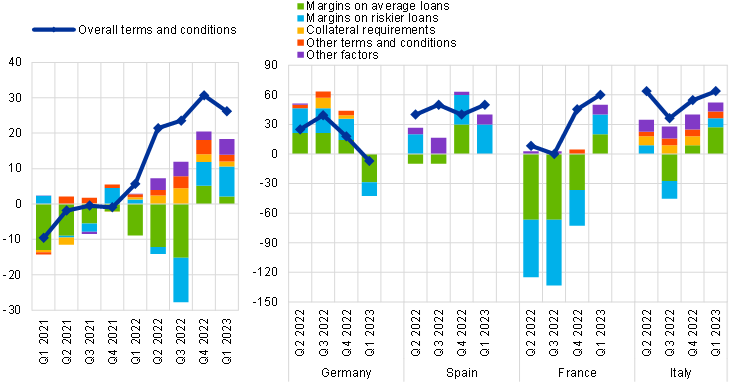
Notes: “Margins” are defined as the spread over relevant market reference rates. “Other terms and conditions” is the unweighted average of “loan-to-value ratio”, “other loan size limits”, “non-interest rate charges” and “maturity”. The net percentages for “other factors” refer to further factors which were mentioned by banks as having contributed to changes in terms and conditions.
Table 6
Changes in terms and conditions on loans to households for house purchase
(net percentages of banks)

Note: See the notes to Chart 9.
Banks’ higher cost of funds and balance sheet situation made the strongest contribution to the net tightening of overall terms and conditions (see Table 7), while competition exerted a widespread easing impact. In addition, banks also mentioned the following as contributors to the tightening of their overall terms and conditions: the level of interest rates, the higher market reference rates to which mortgage loans are linked and the increase in the usury rate in France[5] (see developments by country below). The tightening impact of banks’ risk perceptions and lower risk tolerance became smaller compared with the previous quarter, suggesting that banks did not see economic risks increasing further in the first quarter. By contrast, competition had a net easing impact on terms and conditions.
In most of the large euro area economies, overall terms and conditions for housing loans tightened in net terms. In Italy and Spain, banks referred to the rising level of interest rates (included in “other factors”) in addition to widening loan margins, contributing to tighter overall terms and conditions. By contrast, in Germany, banks reported a net easing of their overall terms and conditions, driven by loan margins. This is in line with the more limited increase in mortgage rates on new loans in Germany in the first quarter compared with the other large euro area countries. The main factor behind this development was intensified competition, which may be related to the strong decrease in demand for housing loans and competition for borrowers between banks. In France, banks referred to a widening of loan margins, partly on account of the update of the administrative threshold for a lending rate to be classified as usury rate (part of “other factors”; see footnote 5). This allowed banks in France to increase the pass-through of ECB rate hikes to mortgage rates, after several quarters in which they had reported a narrowing of loan margins due to the legal constraint of the usury rate. The dominant factor contributing to the tightening of overall terms and conditions in Spain, France and Italy were banks’ funding costs, while competition had an easing impact in Germany, Spain and Italy.
Table 7
Factors contributing to changes in overall terms and conditions on loans to households for house purchase
(net percentages of banks)

Note: The net percentages for these questions relating to contributing factors are defined as the difference between the percentage of banks reporting that the given factor contributed to a tightening and the percentage reporting that it contributed to an easing.
2.2.3 Rejection rate for housing loans increased
In the first quarter of 2023, euro area banks reported a net increase in the share of rejected applications for housing loans, albeit lower than in the previous quarter (net percentage of 17%, after 27%; see Chart 10). This is broadly in line with the moderation in the additional tightening of credit standards in the last two quarters. At the same time, the still substantial net share may reflect banks’ concerns about households’ debt servicing capacity in an environment of higher cost of living and rising interest rates. Banks in Germany, Spain and France reported a net increase in the percentage share of rejected loan applications. By contrast with the other three largest euro area countries, Italian banks reported a net decrease in the share of rejected loan applications.
Chart 10
Changes in the share of rejected loan applications for households
(net percentages of banks reporting an increase)
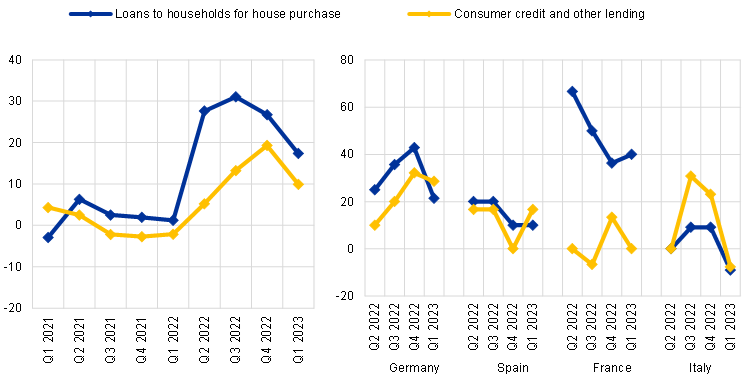
Notes: Share of rejected loan applications relative to the volume of all loan applications in that loan category.
2.2.4 Net demand for housing loans decreased strongly
The net decrease in housing loan demand remained strong and close to the sharp net decrease in the fourth quarter of 2022 (net percentage of banks of -72%, after -74% in the previous quarter; see Chart 11 and Overview table). Both decreases were stronger than in any other quarter since the beginning of the survey in 2003 and consistently stronger than expected by banks in the quarter before.
Chart 11
Changes in demand for loans to households for house purchase, and contributing factors
(net percentages of banks reporting an increase in demand, and contributing factors)

Notes: See the notes to Chart 5. “Other financing needs” is the unweighted average of “debt refinancing/restructuring and renegotiation” and “regulatory and fiscal regime of housing markets”; “use of alternative finance” is the unweighted average of “internal finance of house purchase out of savings/down payment”, “loans from other banks” and “other sources of external finance”.
Higher interest rates, weakening housing market prospects and low consumer confidence all contributed negatively to the demand for loans for house purchase (see Chart 11 and Table 8). For the third quarter in a row, the general level of interest rates remained the main negative contributor to housing loan demand. The negative impact of consumer confidence and housing market prospects was again sizeable in the first quarter of 2023, but remained less negative than the extreme values during the global financial crisis. The development of these factors is in line with the current environment of considerable rises in mortgage rates for euro area households and a substantial slowdown in the annual growth of euro area house prices. Additionally, the European Commission’s consumer confidence indicator remained well below its long-term average for the euro area up to March. To a small extent, other financing needs and the use of alternative finance, mainly due to loans from other banks, also contributed negatively to demand, which is in line with the reported strong competition between banks for granting new housing loans in an increasingly narrow market.
Demand for housing loans decreased substantially in all four largest euro area countries, with very large net decreases in Germany, Spain and France. The general level of interest rates, consumer confidence and housing market prospects all had a downward impact on demand in all four countries. Among these factors, rising interest rates had the strongest dampening impact in all countries. The negative impact of housing market prospects was larger in Germany and France than in Spain and Italy.
In the second quarter of 2023, banks expect a further, although less strong decrease in housing loan demand (net percentage of banks of -39%).
Table 8
Factors contributing to changes in demand for loans to households for house purchase
(net percentages of banks)

Note: See the notes to Chart 11.
2.3 Consumer credit and other lending to households
2.3.1 Credit standards for consumer credit and other lending to households tightened moderately further
Banks reported a moderate further net tightening of credit standards on consumer credit and other lending to households in the first quarter of 2023, which was less pronounced than in the previous quarter (net percentage of 10% after 17% in the previous quarter; see Chart 12 and Overview table). This was broadly in line with banks’ expectations in the previous quarter (net percentage of 13%).
Increased risk perceptions and banks’ lower risk tolerance mainly contributed to the net tightening of credit standards for consumer credit (see Chart 12 and Table 9). This was mostly related to banks’ perceptions of the economic outlook and consumers’ creditworthiness. The tightening impact of banks’ cost of funds and balance sheet conditions remained contained, with small contributions from banks’ liquidity positions, funding costs, capital positions and market financing.
Across the largest euro area countries, credit standards for consumer credit and other lending to households tightened in net terms in Germany and Spain, while they were unchanged on balance in France and Italy. Higher risk perceptions and, to a lesser extent, banks’ lower risk tolerance, contributed to the net tightening in Germany and Spain, while banks’ cost of funds and balance sheet situation also had a relevant tightening impact in Spain.
In the second quarter of 2023, euro area banks expect a further net tightening of credit standards for consumer credit and other lending to households at a similar pace as in the first quarter (net percentage of 12%).
Chart 12
Changes in credit standards applied to the approval of consumer credit and other lending to households, and contributing factors
(net percentages of banks reporting a tightening of credit standards, and contributing factors)
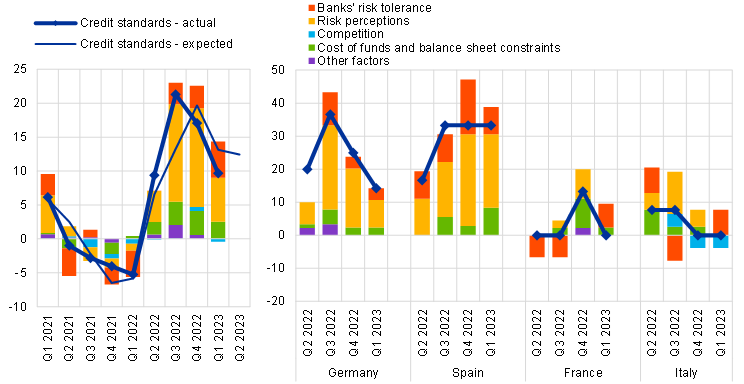
Notes: See the notes to Chart 1. “Cost of funds and balance sheet constraints” is the unweighted average of “banks’ capital and the costs related to banks’ capital position”, “access to market financing” and “liquidity position”; “Risk perceptions” is the unweighted average of “general economic situation and outlook”, “creditworthiness of consumers” and “risk on the collateral demanded”; “competition” is the unweighted average of “competition from other banks” and “competition from non-banks”. The net percentages for “other factors” refer to further factors which were mentioned by banks as having contributed to changes in credit standards.
Table 9
Factors contributing to changes in credit standards for consumer credit and other lending to households
(net percentages of banks)

Note: See the notes to Chart 12.
2.3.2 Terms and conditions on consumer credit and other lending to households tightened further
Banks’ overall terms and conditions applied when granting consumer credit and other lending to households tightened further in net terms in the first quarter of 2023 (net percentage of 18%, after 21% in the previous quarter; see Chart 13 and Table 10). Euro area banks referred mainly to a tightening impact of rising interest rates (part of “other factors”) and, to a small extent, a widening of margins on riskier loans.
Chart 13
Changes in terms and conditions on consumer credit and other lending to households
(net percentages of banks reporting a tightening of terms and conditions)

Notes: “Margins” are defined as the spread over a relevant market reference rate. “Other terms and conditions” is the unweighted average of “size of the loan”, “non-interest rate charges” and “maturity”. The net percentages for “other factors” refer to further factors which were mentioned by banks as having contributed to changes in terms and conditions.
Risk perceptions contributed most to the net tightening of banks’ overall terms and conditions (see Table 11). Rising interest rates and banks’ lower risk tolerance also had a tightening impact on overall terms and conditions, while competition had a net easing impact.
Across all four of the largest euro area countries, overall terms and conditions for consumer credit and other lending to households tightened in net terms. Banks in Germany and Spain reported a widening of loan margins, reflecting the pass-through of higher market rates to lending rates for consumers. By contrast, banks in Italy referred to a narrowing of loan margins in the first quarter, related to the further increase in the general level of interest rates (included in “other factors”), which has not yet been fully passed through to borrowers. Banks in France reported a net tightening of their terms and conditions in the first quarter partly on account of the monthly update of the usury rate (see footnote 5 above). In all of the largest countries, both banks’ cost of funds and balance sheet situation as well as risk perceptions played a relevant role in the tightening of terms and conditions, while competition contributed to an easing in Spain and Italy.
Table 10
Changes in terms and conditions on consumer credit and other lending to households
(net percentages of banks)

Note: See the notes to Chart 13.
Table 11
Factors contributing to changes in overall terms and conditions on consumer credit and other lending to households
(net percentages of banks)

Note: The net percentages for these questions relating to contributing factors are defined as the difference between the percentage of banks reporting that the given factor contributed to a tightening and the percentage reporting that it contributed to an easing.
2.3.3 Rejection rate for consumer credit and other lending to households increased at a lower rate
Euro area banks reported a net increase in the share of rejected applications for consumer credit at a lower rate compared with the previous quarter (10%, after 19% in the previous quarter; see Chart 10 above). Across the largest euro area countries, the net increase in the share of rejected loan applications diminished in Germany and France, while the net percentage of banks reporting an increased share became more pronounced in Spain. In Italy, banks reported a net decrease in the share of loan rejections for consumer credit.
2.3.4 Net demand for consumer credit and other lending to households decreased at a smaller rate
In the first quarter of 2023, banks reported a smaller net decrease in demand for consumer credit and other lending to households (net percentage of banks at -19%, after -30% in the previous quarter; see Chart 14 and Overview table). This decline was broadly in line with what banks had expected in the previous quarter (-18%).
Chart 14
Changes in demand for consumer credit and other lending to households, and contributing factors
(net percentages of banks reporting an increase in demand, and contributing factors)

Notes: See the notes to Chart 5. “Use of alternative finance” is the unweighted average of “internal financing out of savings”, “loans from other banks” and “other sources of external finance”. “Consumption exp. (real estate)” denotes “consumption expenditure financed through real estate-guaranteed loans”.
Higher interest rates, low consumer confidence and a net decline in spending on durable consumer goods contributed, in net terms, to lower demand (see Chart 14 and Table 12). All three factors had a smaller contribution towards the fall in demand relative to the previous quarter. These developments are consistent with the dampening impact of high inflation and elevated energy costs on households’ real disposable income. While the dampening impact remained strong, the moderation in inflation and the reduction in energy supply-related uncertainty improved somewhat the situation for consumers in the first quarter, which may have played a role in the smaller net decrease in loan demand for consumer durables. In addition, the downward impact of consumer confidence in the BLS is consistent with the European Commission’s consumer confidence indicator, which remained below its long-term average in the first quarter.
Across the four largest euro area countries, demand for consumer credit decreased in net terms in Germany, Spain and, to a lesser extent, in Italy, while it remained unchanged in France. The general level of interest rates, low consumer confidence and a net decline in the spending for consumer durables contributed negatively towards demand in all four countries.
In the second quarter of 2023, banks expect a somewhat smaller net decrease in demand for consumer credit and other lending to households (net percentage of -16%).
Table 12
Factors contributing to changes in demand for consumer credit and other lending to households
(net percentages of banks)

Note: See the notes to Chart 14.
3 Ad hoc questions
3.1 Banks’ access to retail and wholesale funding[6]
Euro area banks reported that their access to retail and wholesale funding had deteriorated in the first quarter of 2023. For money markets and debt securities (net percentages of banks at 7% and 13% respectively; see Chart 15), the deterioration reverses the improvement in the access to these markets registered at the end of last year, possibly reflecting the March 2023 market turmoil, the lower overall level of excess liquidity and the increased collateral availability that had stemmed from TLTRO III voluntary early repayments in the last quarter of 2022. The impact of the turmoil also tends to be supported by the fact that the reported deterioration was larger than expected by banks in the previous quarter. The reported deterioration was similar for short-term and longer-term debt securities (net percentages of 12% and 13% respectively). For retail funding (net percentage of 5%), the deterioration in access remained stable compared with the previous quarter and reflects the continued increase in bank deposit rates and shifts towards more highly remunerated types of saving. Access deteriorated for short-term deposits, while it remained broadly unchanged for longer-term deposits (net percentages of 9% and 1% respectively), which is in line with outflows from overnight deposits and shifts into term deposits owing to the stronger interest rate increases for term deposits.
Chart 15
Banks’ assessment of funding conditions and the ability to transfer credit risk off the balance sheet
(net percentages of banks reporting a deterioration in market access)
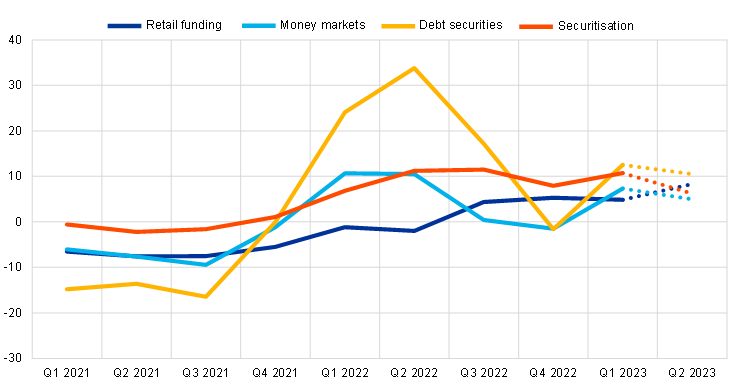
Note: The net percentages are defined as the difference between the sum of the percentages of banks responding “deteriorated considerably” and “deteriorated somewhat” and the sum of the percentages of banks responding “eased somewhat” and “eased considerably”. The last period denotes expectations indicated by banks in the current round.
Table 13
Banks’ assessment of funding conditions and the ability to transfer credit risk off the balance sheet
(net percentages of banks reporting a deterioration in market access)

Note: See the notes to Chart 15.
In the second quarter of 2023 euro area banks expect, on balance, a similar deterioration of their access to money markets and debt securities funding (net percentages of 5% and 11% respectively). Along the same line, a somewhat higher net percentage of banks expects a further deterioration in their access to retail funds compared with the first quarter (net percentage of 8%).
3.2 The impact of the ECB’s monetary policy asset portfolio[7]
3.2.1 Impact of the ECB’s monetary policy asset portfolio on banks’ financial situation
Euro area banks reported, in net terms, that the ECB’s monetary policy asset portfolio had a negative impact on their financing conditions over the last six months (see Chart 16). Banks reported a larger negative impact on their market financing conditions (net percentage of -16%, after -10%) and liquidity position (net percentage of -7%, after -5%), compared with the fourth quarter of 2022. In addition, the impact on banks’ profitability turned broadly neutral (net percentage of 1%, after -2%; see Chart 17), of which the impact via capital losses remained negative. These developments reflect the end of the ECB’s net asset purchases since July 2022 and the switch from full to partial reinvestment of redemptions since the beginning of March 2023. The impact on banks’ total assets was negative, after a positive impact in the previous quarter (net percentage of -4%, after 4%). This is in line with the now negative impact of changes in the ECB’s asset portfolio on lending volumes, which was positive before (see Section 3.2.2 below), as well as the decrease in central bank liquidity.
Chart 16
Overview of the impact of the ECB’s monetary policy asset portfolio on euro area banks’ financial situation
(net percentages of banks reporting an increase/improvement)
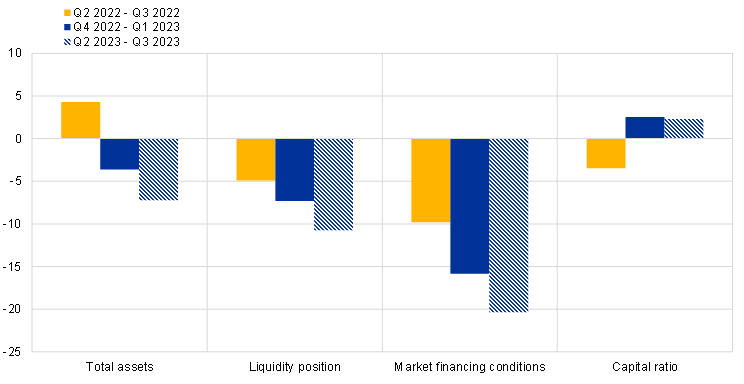
Notes: The net percentages are defined as the difference between the sum of the percentages for “increased/improved considerably” and “increased/improved somewhat” and the sum of the percentages for “decreased/deteriorated somewhat” and “decreased/deteriorated considerably”. The last period denotes expectations indicated by banks in the current round.
Chart 17
Impact of the ECB’s monetary policy asset portfolio on bank profitability
(net percentages of banks reporting an increase/improvement)
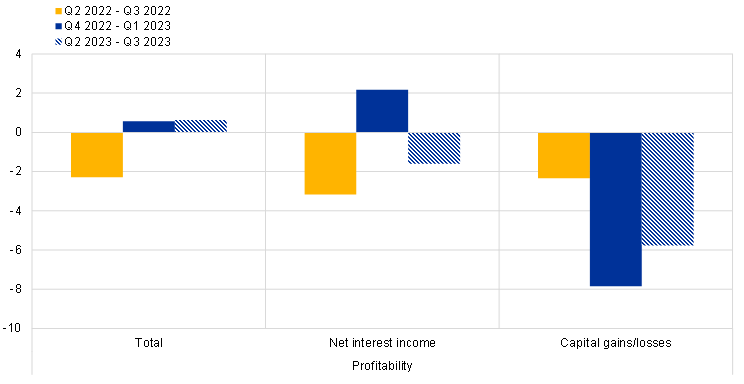
Notes: See the notes to Chart 16. The last period denotes expectations indicated by banks in the current round.
Over the next six months, euro area banks expect, on balance, that the ECB’s monetary policy asset portfolio will continue to have a negative impact on their market financing conditions, liquidity positions and total assets (net percentages of banks of -7%, -11% and -20% respectively). The impact on profitability is expected to remain broadly neutral (net percentage of 1%), with a negative contribution from capital losses (net percentage of -6%).
3.2.2 Impact of the ECB’s monetary policy asset portfolio on banks’ lending conditions and lending volumes
Over the past six months, euro area banks reported a net tightening impact of the ECB’s monetary policy asset portfolio on terms and conditions for loans to enterprises, housing loans and consumer credit (net percentages of banks of 6%, 8% and 5% respectively; see Chart 18). This follows a net easing impact reported in the previous survey for loans to firms and for house purchase, and a broadly neutral impact for consumer credit, reflecting the tightening of monetary policy.
Euro area banks reported, for the first time since this question was expanded to include the impact on lending volumes in 2018, a negative impact of the ECB’s monetary policy asset portfolio on lending volumes for loans to firms, housing loans and consumer credit over the last six months (net percentages of -6%, -12% and -6% respectively; see Chart 18).
Chart 18
Impact of the ECB’s monetary policy asset portfolio on bank lending
(net percentages of banks reporting a tightening)
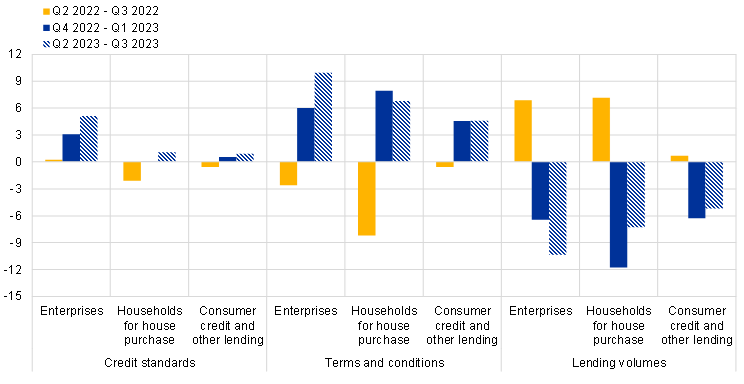
Notes: The net percentages are defined as the difference between the sum of the percentages for “tightened/increased considerably” and “tightened/increased somewhat” and the sum of the percentages for “eased/decreased somewhat” and “eased/decreased considerably”. The last period denotes expectations indicated by banks in the current round.
Over the next six months, banks expect a further tightening impact of the ECB’s monetary policy asset portfolio on their terms and conditions and a further negative impact on lending volumes across all categories of lending. The impact is expected to be greatest for loans to firms (net percentages of banks at 10% for terms and conditions and -10% for lending volumes) followed by housing loans (net percentages of 7% and -7% respectively) and consumer credit (net percentages of 5% and -5% respectively). Banks expect a slight tightening impact on credit standards on loans to firms, and a broadly neutral impact on both forms of lending to households.
3.3 The impact of TLTRO III on banks and their lending policies[8]
Banks indicated a negative impact of the ongoing phase-out of TLTRO III on their liquidity positions and profitability (net percentages of -5% and -7% respectively) over the past six months in the context of TLTRO III maturing or being voluntarily repaid early (see Chart 19). Banks also noted a negative impact on their overall funding conditions for the first time since the start of TLTRO III while the impact on market financing conditions was neutral (net percentages of -9% and 0% respectively; see Chart 19), signalling that the ongoing phase-out of TLTRO III and the less favourable conditions of TLTRO III after the recalibration in October 2022 have effectively induced a tightening of bank funding conditions. The impact of TLTRO III on banks’ ability to fulfil regulatory or supervisory requirements remained positive (net percentage of 7%), although less than before owing to the reduction in outstanding TLTRO III liquidity and its decreased residual maturity.
Over the next six months, banks expect a further negative impact of the phase-out of TLTRO III on their financial situation, especially due to the substantial TLTRO III amount maturing in June 2023. The negative impact is expected to be greatest on their liquidity positions, overall funding conditions and profitability respectively.
Regarding their credit standards, banks reported a tightening impact of TLTRO III on all loan categories over the past six months (net percentages of 4%, 2% and 2% respectively; see Chart 20). Regarding terms and conditions, banks also reported a net tightening impact for both housing loans and consumer credit (both a net percentage of 2%), while the impact on loans to firms was still broadly neutral (net percentage of 1%).
The impact of TLTRO III on bank lending volumes was not markedly positive for the first time. Banks reported a negative impact of TLTRO III for housing loans over the past six months (net percentage of -3%; see Chart 20) and a broadly neutral impact on lending volumes to firms (net percentage of 1%) and for consumer credit (-1%).
Chart 19
Impact of TLTRO III on banks’ financial situation
(net percentages of banks reporting an improvement)
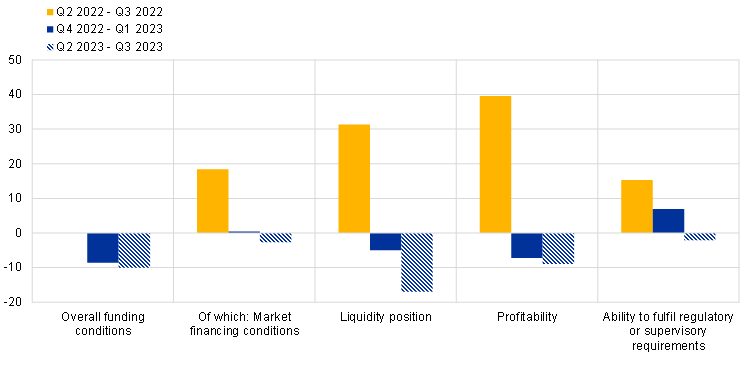
Notes: The signs for these net percentages have been inverted to show net improvements. The net percentages are defined as the difference between the sum of the percentages for “contributed considerably to an improvement” and “contributed somewhat to an improvement” and the sum of the percentages for “contributed somewhat to a deterioration” and “contributed considerably to a deterioration". “Overall funding conditions” was added in the first quarter of 2023. The last period denotes expectations indicated by banks in the current round.
Chart 20
Impact of TLTRO III on bank lending conditions and lending volumes
(net percentages of banks reporting a tightening or increase)
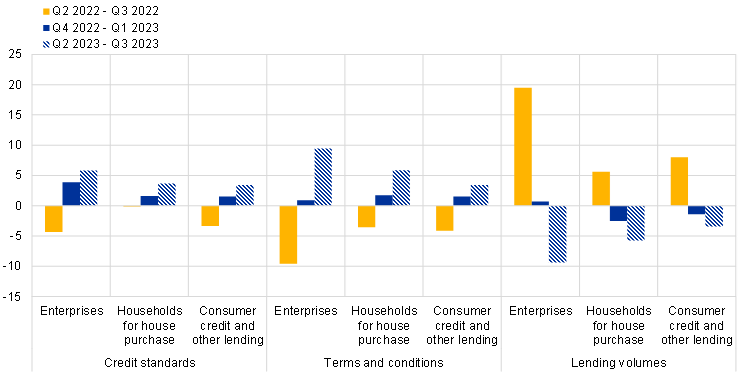
Notes: Net percentages are defined as the difference between the sum of the percentages for “contributed considerably to a tightening or increase” and “contributed somewhat to a tightening or increase” and the sum of the percentages for “contributed somewhat to an easing or decrease” and “contributed considerably to an easing or decrease". The last period denotes expectations indicated by banks in the current round.
Over the next six months, euro area banks expect a strong tightening impact of the phase-out of TLTRO III on terms and conditions and credit standards as well as a marked reduction in lending volumes, consistent with the maturity of outstanding TLTRO III in June 2023.
3.4 The impact of ECB key interest rate decisions on bank profitability[9]
Euro area banks reported a markedly positive impact of the ECB key interest rate decisions on their net interest margins over the past six months, according to a new question that was introduced in this survey round. The positive impact on bank interest margins (net percentage of banks at 49%; see Chart 21) translated into a high share of banks reporting a positive impact of the ECB rate hikes on their net interest income (net percentage of 47%), which led to a largely positive effect on their overall profitability (net percentage of 40%).[10] At the same time, the impact of the ECB interest rate decisions on volumes was negative, consistent with sharply decelerating loan demand as reported elsewhere in the survey and weakening deposit dynamics, exerting a dampening impact on bank profitability according to the banks (net percentage of -17%). This direct evidence from the banks on the impact of the ECB rate hikes on their financial situation is consistent with the changes in the components of bank profitability up to the fourth quarter of 2022 (latest available data from supervisory banking statistics). Banks’ BLS replies, covering the period up to the first quarter of 2023, suggest a continuation of these developments. In particular, the negative volume effect is in line with the substantial weakening of loan and deposit dynamics over the past six months. In addition, euro area banks reported a negative impact of the ECB interest rate decisions on profitability via their non-interest income (net percentage of -11%). This is owing to both capital losses (net percentage of -12%), reflecting losses in banks’ securities portfolios in the context of rising interest rates, as well as net fee and commission income (net percentage of -13%). Banks have also indicated a dampening impact of the ECB rate hikes on profitability via higher provisioning needs and impairments (net percentage of banks at -9%) over the past six months, which may reflect higher credit risks associated with a weakening impact of monetary policy tightening on economic activity and a rising interest burden of borrowers.
Chart 21
Impact of ECB interest rate decisions on euro area bank profitability
(net percentages of banks; over the past six months and the next six months)
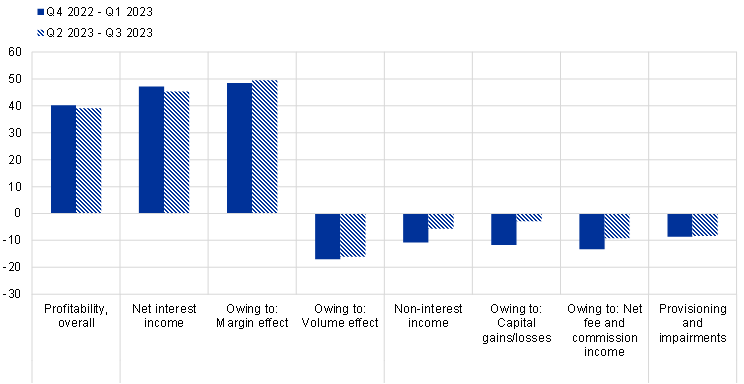
Notes: The net percentages refer to the difference between the sum of the percentages of banks responding “increased considerably” and “increased somewhat” and the sum of the percentages of banks responding “decreased somewhat” and “decreased considerably". The dashed bars denote expectations indicated by banks in the current round.
Euro area banks expect the mostly similar impacts of the ECB key interest rate decisions on the components of bank profitability over the next six months, except for capital losses, which banks expect to be lower. Banks expect a similar positive impact of the ECB’s interest rate decisions on their net interest margins (net percentage of 50%), which will support their net interest income (45%) and overall profitability (39%) despite the negative volume effect (net percentage of -16%) over the next six months. By contrast, the dampening impact of the ECB interest rate hikes via capital losses is expected to become smaller (net percentage of -3%) while the dampening impact on banks’ profitability via higher provisioning needs and impairments is expected to remain similar (net percentage of -8%).
Annexes
See more.
© European Central Bank, 2023
Postal address 60640 Frankfurt am Main, Germany
Telephone +49 69 1344 0
Website www.ecb.europa.eu
All rights reserved. Reproduction for educational and non-commercial purposes is permitted provided that the source is acknowledged.
For specific terminology please refer to the ECB glossary (available in English only).
PDF ISSN 1830-5989, QB-BA-23-001-EN-N
HTML ISSN 1830-5989, QB-BA-23-001-EN-Q
The four largest euro area countries in terms of GDP are Germany, France, Italy and Spain.
For more detailed information on the bank lending survey, see the article entitled “A bank lending survey for the euro area”, Monthly Bulletin, ECB, April 2003; Köhler-Ulbrich, P., Hempell, H. and Scopel, S., “The euro area bank lending survey”, Occasional Paper Series, No 179, ECB, 2016; and Burlon, L., Dimou, M., Drahonsky, A. and Köhler-Ulbrich, P., “What does the bank lending survey tell us about credit conditions for euro area firms?”, Economic Bulletin, Issue 8, ECB, December 2019.
To ensure a good representation of national bank lending markets, the selected sample banks are generally of a similar size or have lending behaviour that is typical of a larger group of banks.
The non-harmonised historical data differ from the harmonised data mainly as a result of heterogeneous treatment of “NA” (Not Applicable) replies and specialised banks across questions and countries. Non-harmonised historical BLS data are published for discontinued BLS questions and ad hoc questions.
The usury rate (taux d’usure) is set by the Banque de France and corresponds to the maximum legal interest rate that credit institutions are authorised to charge on a list of different categories of loans to protect borrowers from being charged excessive rates. The usury rates are set on the basis of the average of the rates practiced during the three previous months. From 1 February 2023, on an exceptional basis to better smooth the increases in the usury rate, the update of the usury rates is monthly instead of quarterly for the rates applicable from 1 February to 1 July 2023 (see this link). The current list of usury rates for France can be found under this link.
The April 2023 survey included a question in which banks were asked to assess the extent to which the situation in financial markets has affected their access to retail and wholesale funding.
The April 2023 survey questionnaire included two biannual ad hoc questions gauging the impact of the ECB’s monetary policy asset portfolio over the period under review, which may result from net asset purchases or any other transactions, including reinvestments of the principal payments from maturing securities purchased. These questions follow up from the previous questions on the ECB’s asset purchases. Changes in the ECB's monetary policy asset portfolio can be related to the following (potential) monetary policy tools: corporate sector purchase programme (CSPP), public sector purchase programme (PSPP), asset-backed securities purchase programme (ABSPP), covered bond purchase programme (CBPP), pandemic emergency purchase programme (PEPP), Outright Monetary Transactions (OMT), and Transmission Protection Instrument (TPI). Banks were asked to consider both direct and indirect effects of the changes in the ECB’s monetary policy asset portfolio.
The April 2023 survey questionnaire included a biannual ad hoc question on the impact of the Eurosystem’s third targeted longer-term refinancing operation (TLTRO III), for which all operations took place, and which will be fully matured by December 2024. Banks were asked to consider the impact of any changes in the relative funding advantage of your banks' outstanding TLTRO III funds arising from ECB key interest rate changes and/or the TLTRO III recalibration, as well as any change in their bank's overall funding conditions due to the maturity or early repayment of TLTRO III funds.
The April 2023 survey questionnaire included a new biannual ad hoc question aimed to collect information on the impact of ECB key interest rate decisions on bank profitability over the past and next six months. Banks were asked to report on the impact on their profitability overall, as well as the impact on their net interest income, non-interest income and banks’ need for provisioning and impairments.
The net interest income is defined as the difference between the interest income earned and interest expenses paid on the outstanding amount of interest-bearing assets and liabilities by the bank. Margin effects relate to changes in the interest rates of these assets and liabilities, while volume effects relate to changes in the volumes.
-
2 May 2023


